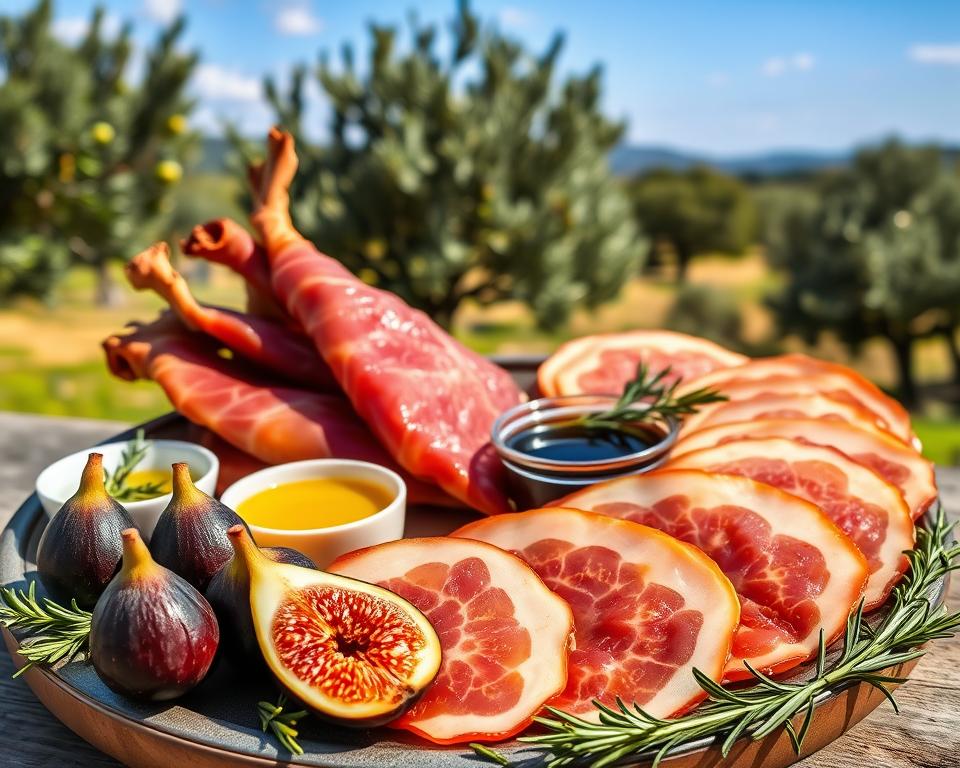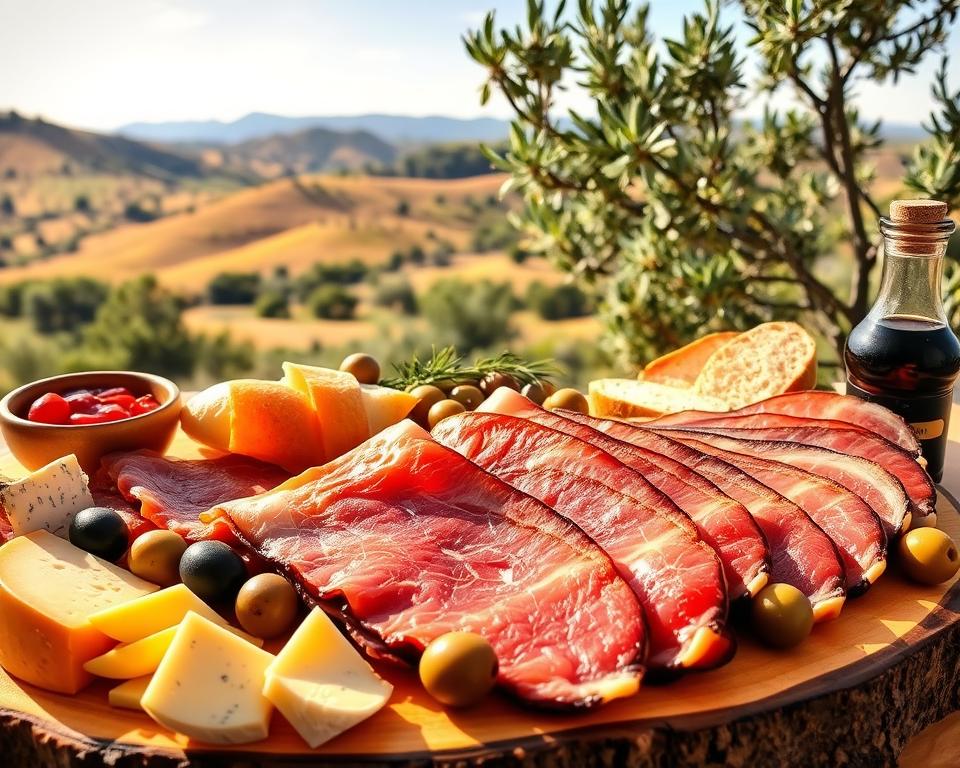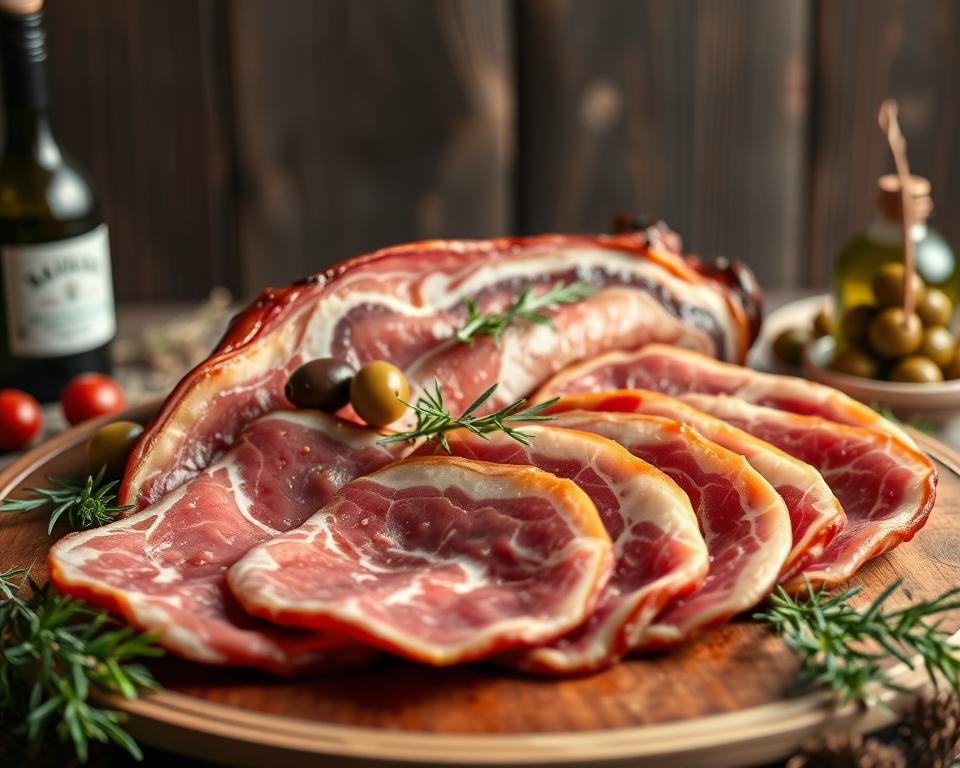In Spain’s green hills and sunny plains, a special food treasure is found: pata negra, the amazing Iberian ham. Known also as jamón ibérico, it comes from a long tradition. This tradition honors Spain’s nature and the skill of its curers.
The name “pata negra” means “black hoof” because of the pigs’ black hooves. These pigs eat acorns and other plants from the land. This diet makes the ham taste rich and feel soft in your mouth. The curing process, which lasts for years, makes it even better, turning it into a true Spanish delicacy.
Originally a local favorite, pata negra is now loved all over the world. It shows Spain’s deep food culture and tradition. You can enjoy it as a snack, in a big dish, or by itself. This gourmet Spanish ham shows the value of patience, tradition, and striving for the best.
Read interesting things at : vsocan
Key Takeaways
- Pata negra is Spain’s finest Iberian ham, renowned for its unique flavor and texture.
- The black-hoofed Iberian pigs that produce pata negra are fed a diet rich in acorns, imparting the ham with a distinctive taste.
- The curing process for pata negra can take several years, refining the ham’s texture and depth of flavor.
- Pata negra has become an integral part of Spain’s culinary heritage and cultural identity.
- This gourmet Spanish ham can be enjoyed in a variety of ways, from tapas to main course dishes.
What is Pata Negra?
Pata negra, also known as jamón ibérico, is a highly prized Iberian ham. It comes from the black Iberian pig. This pig is mainly found in the Iberian Peninsula, where it eats a lot of acorns. This diet is key to the ham’s unique flavor and texture.
The Unique Black Iberian Pig
The black Iberian pig, or cerdo ibérico, is native to the Iberian Peninsula. They have dark black or reddish-brown coats, earning them the name “pata negra” or “black hoof.” Their diet of acorns, called “bellota,” from oak forests gives their meat a rich, nutty flavor.
Traditional Curing Methods
Making pata negra ham is a detailed, traditional process. After the pigs are slaughtered, the hams are cured with salt, air-dried, and aged. This long process, which can last up to 36 months, develops the ham’s unique flavor and texture. The result is a delicacy known for its deep, umami-rich taste and soft quality.
Pata negra, or Iberian ham, is a true culinary treasure. It shows the rich cultural heritage and gastronomic traditions of Spain. Its unique production and the exceptional quality of the black Iberian pig make it a standout among the world’s finest cured meats.
The Birthplace of Pata Negra
The story of pata negra, the exquisite Iberian ham from Spain, begins in the Iberian Peninsula. This region’s unique terroir and climate are key. The southern areas are home to black Iberian pigs. They roam freely, eating acorns and herbs.
Jabugo and Guijuelo, in Andalusia, are famous for pata negra. Their mild climate and oak forests are perfect for the pigs. This environment helps create the ham’s unique flavors.
| Region | Key Characteristics |
|---|---|
| Jabugo | Situated in the Sierra de Aracena, Jabugo is renowned for its long-standing tradition of curing pata negra. The region’s mild, humid climate and extensive oak forests create the ideal conditions for the black Iberian pigs to forage on a diet of acorns, resulting in a complex, nutty flavor profile. |
| Guijuelo | Located in the province of Salamanca, Guijuelo enjoys a continental climate with warm summers and cold winters. The local black Iberian pigs thrive in this unique environment, producing pata negra with a delicate balance of sweetness and saltiness. |
Jabugo and Guijuelo have made pata negra a symbol of Spanish culinary excellence. Their terroir and climate are key to the ham’s flavor. This makes pata negra a delicacy loved around the world.
“The birthplace of pata negra is not just a geographic location, but a living testament to the harmonious relationship between the land, the animals, and the skilled artisans who have perfected this timeless craft.”
The Distinctive Flavor of Acorn-Fed Ham
The secret to pata negra, or Iberian ham, is the black Iberian pigs’ diet. They roam in Spain’s oak forests, eating lots of acorns. This diet gives the gourmet Spanish ham a unique, nutty undertone.
The ham’s flavor gets even better with a slow curing process. This can take up to 36 months. As it ages, the acorn fat spreads evenly, making the ham soft and unforgettable.
Melts in Your Mouth
Pata negra is known for its amazing mouthfeel. The acorn diet and careful curing make it ham that literally melts on your tongue. It’s a sensory delight, with silky-smooth texture and rich, nutty flavors.
| Flavor Profile | Texture |
|---|---|
| Rich, nutty undertones | Melt-in-your-mouth |
| Acorn-fed diet | Silky-smooth |
| Slow curing process | Evenly distributed fat |
Pata Negra’s Culinary Versatility
Pata Negra, the exquisite Iberian ham from Spain, is famous for its unique taste. It’s also known for its versatility in cooking. This Spanish delicacy can make any meal special and highlight Spanish cuisine’s depth.
Tapas and Appetizers
In Spain’s lively tapas scene, pata negra is a key ingredient. It brings a rich, nutty flavor to many small dishes. Thin slices of this iberian ham pair well with crisp bread, tangy cheeses, or zesty olives.
This combination creates a perfect mix of flavors and textures. Whether it’s served alone or in a complex tapa, pata negra always impresses.
Main Course Dishes
Pata negra’s versatility goes beyond tapas and appetizers. It can also enhance main courses, making traditional Spanish dishes even better. Its strong, umami flavor adds depth to stews, paellas, and pasta.
This turns these dishes into unforgettable meals. It shows how pata negra can elevate any dish.
“Pata negra is a true ambassador of Spanish gastronomy and cuisine, showcasing the country’s rich culinary heritage and unparalleled artisanal expertise.”
The Art of Slicing Iberian Ham
Slicing pata negra, the exquisite Iberian ham, is a true culinary art form. The intricate technique, known as “the art of the cortador,” is essential in preserving the unique texture and flavor of this Spanish charcuterie delicacy.
The key to expertly slicing pata negra lies in the use of a specialized knife, known as a jamonero. This sharp, long blade allows the cortador, or ham slicer, to carefully carve thin, delicate slices that melt effortlessly on the tongue. The angle and pressure applied during the slicing process are crucial, as they determine the thickness and consistency of the final product.
Proper presentation is also paramount when serving Iberian ham. The slices should be carefully arranged on a platter, showcasing their rich, glistening hues and intricate marbling. This visual display not only enhances the overall dining experience but also allows the subtle nuances of the Spanish delicacy to shine.
“The art of slicing pata negra is a time-honored tradition that requires patience, skill, and a deep appreciation for the product. Each slice is a work of culinary art.”
Whether enjoyed as a tapas, appetizer, or incorporated into a main course, the proper slicing and presentation of pata negra are essential in unlocking its full flavor potential and honoring the centuries-old legacy of this Spanish charcuterie icon.
Pata Negra’s Nutritional Benefits
Pata negra, the exquisite Iberian ham, is a culinary delight and a nutritional powerhouse. It’s known for its exceptional quality and unique flavor. But did you know it also offers many health benefits?
This Spanish delicacy is high in protein. Iberian ham is a great source of lean, high-quality protein. It’s essential for muscle development, repair, and maintaining a healthy body composition. Plus, pata negra is rich in healthy fats, like oleic acid. These fats have been linked to a reduced risk of heart disease and improved cholesterol levels.
Pata negra is also packed with essential vitamins and minerals. It’s a good source of vitamin B12, crucial for red blood cell formation and neurological function. It also contains iron, vital for transporting oxygen throughout the body. Plus, pata negra has selenium, an antioxidant that supports immune system function and may have anti-cancer properties.
When enjoyed as part of a balanced, healthy Spanish diet, pata negra can be a great addition. The key is to enjoy it in moderation, as with any high-calorie food. By adding this delectable Iberian ham to your meals, you can enjoy a flavorful and nutritious experience.

“Pata negra is not just a treat for the taste buds, but also a gift for our overall well-being.”
Authentic vs. Imitation: Spotting the Difference
In the world of pata negra, it’s key to tell real from fake. Real pata negra shows centuries of tradition and high quality. Fake ones lack in taste and origin.
Quality Assurance Seals
Looking for quality seals is a good way to find real pata negra. Seals like the Denominación de Origen Protegida (DOP) and the Jamón de Jabugo mark show it meets Spain’s strict rules.
- The DOP seal means the pata negra was cured and aged in certain places, using old methods.
- The Jamón de Jabugo seal proves the ham comes from Jabugo, known for its top-notch iberian ham.
These seals prove the pata negra is real and of high quality. They give buyers peace of mind they’re getting a great product.
“Authentic pata negra is a delicacy that can only be achieved through the meticulous adherence to traditional curing methods and the careful selection of the finest iberian ham.”
Pairing Pata Negra with Wines and Spirits
Pata Negra, the exquisite Iberian ham, is a delight on its own. It shines when paired with the right wines and spirits. The rich, nutty flavors of this Spanish delicacy create a harmonious balance with carefully selected beverages.
When it comes to wine pairing, Pata Negra’s robust flavors complement many Spanish wines. A full-bodied red wine, like a Rioja or a Tempranillo, brings out the ham’s nuttiness. It also offers a smooth finish. On the other hand, a crisp white wine, such as an Albariño or a Verdejo, provides a refreshing contrast to the ham’s richness.
Spirits also enhance the unique taste of Pata Negra. A well-crafted Spanish sherry, like a Fino or an Oloroso, pairs beautifully. The ham’s umami notes and the sherry’s complex flavors create a harmonious union. For a modern twist, a premium Spanish gin or a smooth Iberian brandy can also complement this Spanish treasure.
| Pata Negra Pairing | Recommended Beverage | Flavor Profile |
|---|---|---|
| Red Wine | Rioja, Tempranillo | Full-bodied, robust, with notes of dark fruit and oak |
| White Wine | Albariño, Verdejo | Crisp, aromatic, with refreshing acidity |
| Sherry | Fino, Oloroso | Complex, nutty, and subtly sweet |
| Spirits | Spanish Gin, Iberian Brandy | Smooth, aromatic, and complementary to the ham’s richness |
Exploring wine and spirit pairings, Pata Negra can be celebrated in many ways. It becomes a true centerpiece of Spanish gastronomy and culture.
The Best Regions for Pata Negra
When it comes to pata negra, or Iberian ham, Jabugo and Guijuelo in Spain are the top spots. These areas are known for their top-notch Spanish charcuterie.
Jabugo
Jabugo is in Andalusia, famous for its pata negra. The mild climate and rich acorn pastures are perfect for Iberian pigs. These pigs eat acorns, giving the ham a rich, nutty taste and a soft texture.
Guijuelo
Guijuelo in Castile and León is another top spot for pata negra. The ham here is known for its unique taste, thanks to the cool, dry climate and traditional curing. This makes the pata negra here unmatched in flavor and texture.
| Region | Unique Characteristics | Production Techniques |
|---|---|---|
| Jabugo | Mild climate, acorn-rich pastures | Raising Iberian pigs on a diet of sweet acorns |
| Guijuelo | Cool, dry climate | Traditional curing methods by local artisans |

“The pata negra from Jabugo and Guijuelo are truly the pinnacle of Spanish charcuterie excellence, showcasing the country’s rich culinary heritage and the dedication of its artisanal producers.”
Pata Negra in Spanish Gastronomy and Culture
Pata negra, the exquisite Iberian ham, is deeply ingrained in Spanish gastronomy and cultural identity. It has become more than just food, symbolizing Spanish culinary heritage.
In Spanish cuisine, pata negra is a versatile ingredient. It’s found in both casual tapas bars and Michelin-starred restaurants. From jamón serrano to jamón ibérico de bellota, it adds flavor and texture to dishes like bocadillos, paella, and gazpacho.
Pata negra also holds a special place in Spanish cultural traditions. It’s a key part of family gatherings, social events, and religious festivities. It symbolizes hospitality and the shared love for Spanish food.
The tradition of cortando el jamón, or slicing the Iberian ham, is a big part of Spanish culture. Skilled ham carvers, known as cortadores, are celebrated for their skill. They turn the cured ham into delicate, paper-thin slices, showing off its flavors.
“Pata negra is not just a food – it’s a way of life, a connection to our history and the land that nourishes us.”
The legacy of pata negra in Spanish gastronomy and culture shows the country’s love for artisanal craftsmanship. It highlights the importance of preserving traditional methods and celebrating local produce. As Spain’s culinary scene continues to grow, pata negra remains a symbol of its commitment to its gastronomic heritage.
Purchasing and Storing Pata Negra
Getting your hands on pata negra, or Iberian ham, is a treat for food lovers. With its fame spreading worldwide, online stores now make it easy to buy. But, keeping it fresh is key to enjoying its full taste and texture.
Online Retailers
Online shopping has made buying pata negra simple. Trustworthy websites offer many types of Iberian ham. They give you all the details, reviews, and safe shipping. This makes it easy for both new and experienced fans to buy.
Proper Storage Techniques
- Temperature control: Pata negra loves a cool, dry spot. Keep it between 55-65°F (13-18°C). Avoid hot spots or sudden changes.
- Humidity management: Keep humidity at 60-80%. This stops the ham from drying out or getting too wet, which can cause mold.
- Handling and slicing: Be gentle with the ham. Use a sharp knife for slicing to keep its texture and taste.
- Vacuum sealing: Sealing it in a vacuum bag helps it last longer. It also stops the ham from getting a bad taste or smell.
Following these storage tips lets you enjoy pata negra for longer. You’ll get to taste its rich, nutty flavors and soft texture.
Conclusion
We’ve explored the amazing story of pata negra, the top-notch Iberian ham. It’s a key part of Spain’s charcuterie tradition. We’ve looked at how the black Iberian pig and old curing ways make pata negra a culinary gem.
This article took us from the birthplace of pata negra in the Iberian Peninsula. We learned about the pigs’ diet and how it affects the ham’s flavor. We also saw how pata negra can make any dish better, from tapas to big meals.
In wrapping up, pata negra is more than tasty Iberian ham. It shows Spain’s deep food culture and history. This piece hoped to make you love pata negra more. It’s a symbol of Spanish gastronomy and heritage.


